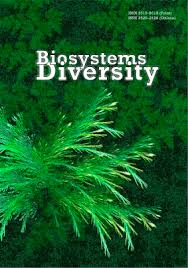A systematic review of flukes (Trematoda) of domestic goose (Anser anser dom.)
A systematic review of flukes (Trematoda) of domestic goose (Anser anser dom.)
Author(s): F. H. RzayevSubject(s): Energy and Environmental Studies, Regional Geography, Environmental Geography
Published by: Дніпропетровський національний університет імені Олеся Гончара
Keywords: fauna; systematic classification; helminthes; water bird; Azerbaijan;
Summary/Abstract: Trematodes are one of the most numerous and widespread groups of parasitic invertebrates among helminths, characterized by a complex life cycle. As the final host, digenetic flukes parasitize vertebrates, including domestic waterfowl. Infection of hosts with parasitic digenetic worms causes huge economic damage to poultry. But trematode fauna of domestic geese are presented mainly only for individual regions. Despite the fact that there is already a systematic review of tapeworms and acanthocephala of domestic birds - geese and ducks, there are, unfortunately, no review articles on the taxonomy of digenetic flukes for geese (Anser anser dom.). Taking into account the relevance of the topic, based on our own and extensive literature data, we set the task to determine the general species composition of digenetic flukes (Trematoda), parasitizing in domestic geese which have been recorded in the world until 2020. Each Trematoda species is provided with the following data: scientific name, authority and year, first, second intermediate, auxiliary and final hosts, site in the host body, collecting localities and geographic distribution, and literature sources. Currently it is established that there are 149 species of helminths parasitising domestic geese. The taxonomic composition of the class Trematoda registered in domestic geese consists of 2 classes, 14 families, 30 genera and 65 species. Of all the species of trematodes parasitizing in domestic geese, 44 species have been recorded in Europe, 26 species in Asia, 6 species in North America, 1 species in South America, 1 species in Africa and 2 species in Oceania. Three species are registered in domestic geese (Echinoparyphium recurvatum, Echinostoma revolutum, Prosthogonimus ovatus) are cosmopolitan parasites. The biggest species diversity is characterized by the families Echinostomatidae (17 species) and Notocotylidae (12 species). There are 11 species of digenetic flukes recorded in domestic geese Cyclocoelum mutabile, Echinostoma grande, E. paraulum, E. revolutum, E. robustum, Hypoderaeum conoideum, Paryphostomum novum, P. pentalobum, Catatropis verrucosa, Notocotylus attenuatus, N. parviovatus) on the territory of Azerbaijan. Four of them (Echinostoma revolutum, Hypoderaeum conoideum, Paryphostomum novum, Notocotylus attenuatus) were also noted in the course of our helminthological studies. The trematode Cyclocoelum mutabile was recorded in domestic ducks only in Azerbaijan. Most species of trematodes were found in the north-eastern part (total 9 species) and southern part (total 5 species) of Azerbaijan. This is due to the widespread distribution of molluscs - intermediate hosts of digenetic flukes, in these regions. Eighteen species of digenetic flukes parasitize both birds and mammals (Rodentia, Carnivora, Lagomorpha, Artiodactyla). And eleven species of trematodes are of medical importance, registered in humans.
Journal: Biosystems Diversity
- Issue Year: 29/2021
- Issue No: 3
- Page Range: 294-302
- Page Count: 9
- Language: English

